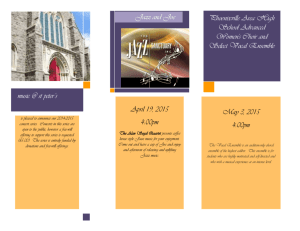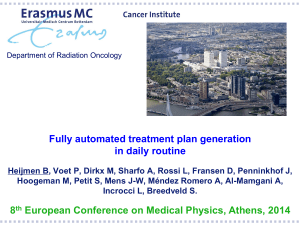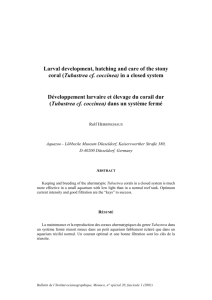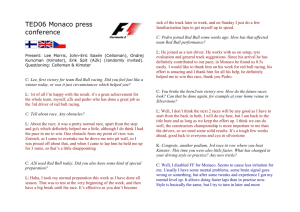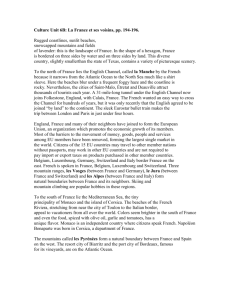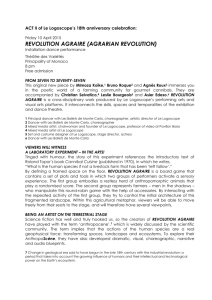Monaco Profile
advertisement
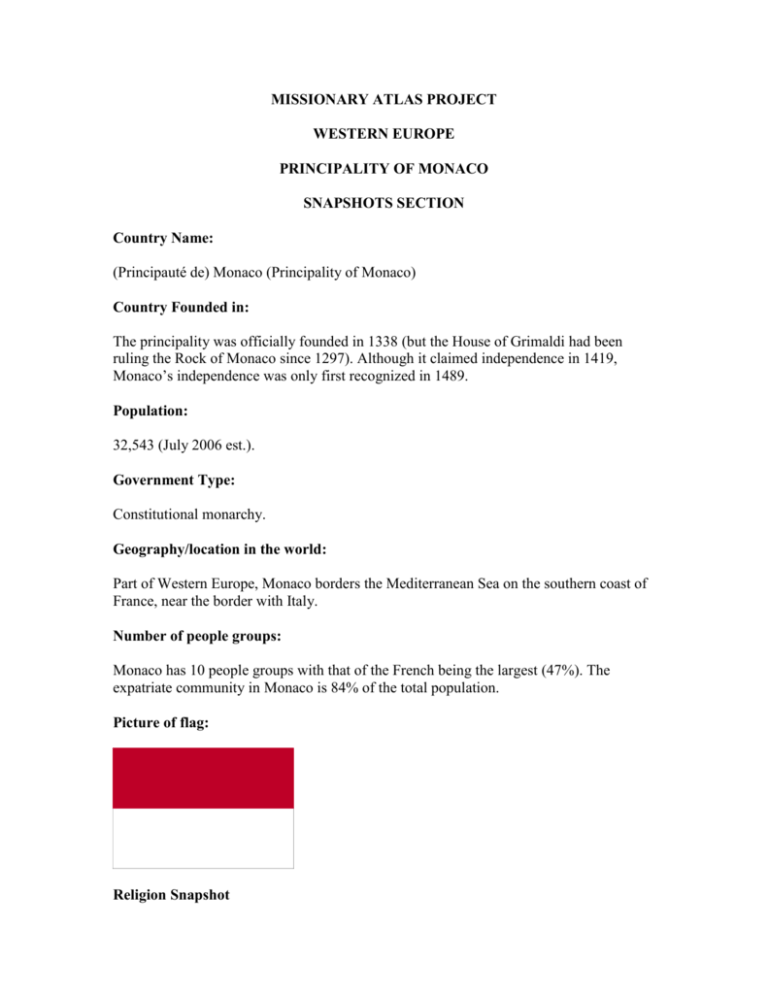
MISSIONARY ATLAS PROJECT WESTERN EUROPE PRINCIPALITY OF MONACO SNAPSHOTS SECTION Country Name: (Principauté de) Monaco (Principality of Monaco) Country Founded in: The principality was officially founded in 1338 (but the House of Grimaldi had been ruling the Rock of Monaco since 1297). Although it claimed independence in 1419, Monaco’s independence was only first recognized in 1489. Population: 32,543 (July 2006 est.). Government Type: Constitutional monarchy. Geography/location in the world: Part of Western Europe, Monaco borders the Mediterranean Sea on the southern coast of France, near the border with Italy. Number of people groups: Monaco has 10 people groups with that of the French being the largest (47%). The expatriate community in Monaco is 84% of the total population. Picture of flag: Religion Snapshot Major Religion and % of population: Roman Catholicism (83.34%). All religions and % for each: Christian: Roman Catholicism, 83.34% Protestant, 2.98% Independent, 0.15% Anglican, 0.95% Orthodox, 0.24% Christian Cults/Sects: None found Other: Jewish, 1.70% Muslim, 0.50% Non-religious and other, 10.14% Government interaction with religion: Article 9 of the Monegasque constitution reads “La religion catholique, apostolique et romaine est religion d'Etat.” (Translation: “The Catholic, Apostolic, and Roman religion is the religion of the State.”) The constitution also provides for religious freedom. Proselytism, however, is strongly discouraged. Sources consulted: Worldmark Encyclopedia of the Nations, vol. 5: Europe, 10th ed. (Detroit: Gale Group, 2001) Patrick Johnstone and Jason Mandryk, Operation World. 21st Century Edition (William Carey Library Publishers and Distributors, 2001. http://www.state.gov/r/pa/ei/bgn/3397.htm https://www.cia.gov/cia/publications/factbook/print/mn.html Country Profile Monaco Basic Facts Name: Principauté de Monaco; Principality of Monaco Demographics: Monaco’s population numbers 32,543 (July 2006 est.). The age structure is as follows (2006 est.): 0-14 years: 15.2% (male 2,539/female 2,417) 15-64 years: 62.1% (male 9,959/female 10,266) 65 years and over: 22.6% (male 3,015/female 4,347) The median age is 45.4 years (43.3 years for males; 47.3 years for females). With a birth rate of 9.19 births/1,000 population, 12.91 deaths/1,000 population, and a net migration rate of 7.68 migrants/1,000 population, Monaco’s population growth rate for 2006 was 0.4%. The sex ratio is as follows: At birth: 1.05 males/female Under 15 years: 1.05 males/female 15-64 years: 0.97 males/female 65 and over: 0.69 males/female Total population: 0.91 males/female The life expectancy at birth is 79.69 years (75.85 years for males; 83.74 years for females). The average age is 46, the highest in the world. The fertility rate is 1.76 children born per woman (2006 est.). Monaco’s urbanization rate is nearly 100%. Monaco has 10 people groups with that of the French being the largest (47%). The expatriate community in Monaco comprises 84% of the total population. Monaco is the world’s most densely populated country. Per capita, Monaco has more millionaires than any other country. Language: As stipulated in Article 8 of the Constitution, French is the official language of Monaco. French is an Indo-European, Romance language spoken by everyone in Monaco. Besides the official language of French, Monaco has 3 unofficial languages: English, Italian, and Monegasque or Ligurian. Monegasque is the national language of the Monegasque people (16% of the population). The Monegasque language “has its origins in the Genoese dialect of Italian and the Provencal language of southern France” (Worldmark Encyclopedia of the Nations, vol. 5: Europe, 10th ed. (Detroit: Gale Group, 2001), 331) and as such is an Indo-European language. Prince Albert II’s coronation speech to the people was made in the Monegasque language. Italian is also an Indo-European, Romance language and spoken by about 16% of the population. English is the 3rd unofficial language and is spoken by the Englishspeaking community and many tourists. http://www.ethnologue.com/show_country.asp?name=MC http://en.wikipedia.org/wiki/Languages_of_Monaco Society/Culture: Living conditions in Monaco are favorable: the standard of living is high with “the greatest per capita income and the highest level of car ownership in the world” (Timothy L. Gall, ed., Worldmark Encyclopedia of Cultures and Daily Life, vol. 4 Europe (Detroit: Gale Research, 1998), 257). Bus service is frequent as is train service. The nearest airport, in Nice (France), is only 6 mi (10 km) away. Monaco has its own harbor providing sea access. Luxury housing is in high demand with some apartments renting for $20,000 per month. The cost of a 1-bedroom apartment is up to $600,000. Street crime in Monaco is almost non-existent due to a well-functioning police force and an effective 81 surveillance camera system. Excellent health care is available to all citizens. An average age of 46 and a life expectancy of almost 80 years indicate the good health most people enjoy. People dress according to the latest fashion. While the dress on the beach may be very revealing, off the beach one finds multilingual signs that read “Apart from the immediate vicinity of the beaches and bathing facilities it is forbidden to walk around bare-chested, wearing only a swimming costume, or barefoot. Failure to comply with these regulations could result in prosecution” (ibid.). The typical Monegasque family consists of parents and 1 or 2 children. The immediate and extended family is very important to the people of Monaco. Marriage is viewed as an important family event and the divorce rate is low (less than 25%) (http://www. everyculture.com/Ma-Ni/Monaco.html). Church weddings are popular and are according to the liturgy of the Roman Catholic Church. A civil wedding at the city hall is required even when a church wedding is organized. Since the Monegasque citizens number but a little over 5,000, they enjoy a rather personal relationship with the royal family. The palace is open to all citizens to celebrate major events, such as christenings, engagements, and weddings, in the life of the Grimaldi royal family. All Monegasque children under age 12 celebrate Christmas annually at the palace with a party including entertainment, refreshments, and a gift for every child. School attendance is compulsory for children between the ages of 6 and 16. The curriculum is based on that of the French school system. In Monaco, however, children learn some of the Monegasque history and language in addition to the regular curriculum. Attendance is 90% and literacy 99%. Monaco offers education from preschool to secondary and technical levels (http://www.nationsencyclopedia.com/Europe/MonacoEDUCATION.html). The International University of Monaco offers some undergraduate degrees and a 10month MBA program (http://www.visitmonaco.com/index.cfm? fuseaction=Page.viewPage&pageId=425). The Monegasques have the right of free education on the primary and secondary levels (Article 27 of the Constitution). People in Monaco greet each other with handshakes or sometimes with kisses on both cheeks. Discretion and privacy are highly valued in Monegasque culture. Other aspects of etiquette are similar to those of France. Another important aspect of Monegasque culture is religious rituals. Since the Roman Catholic Church is the state church, rites of passage like baptism, 1st Communion, confirmation, marriage, and burial take place in the Catholic Church. A rite of passage, which is celebrated outside the church, is graduation from school. Many families throw parties for their graduating children. St. Devote, a 3d-century Christian martyr and Monaco’s patron saint, is venerated annually on January 26, a holiday. Other holidays in Monaco are New Year’s Day (January 1), Easter, Labor Day (May 1), Ascension Day, Pentecost Monday, Festival of St. John (June 24), Feast of the Assumption (August 15), All Saints’ Day (November 1), Immaculate Conception (December 8), and Christmas (December 25). Monte Carlo’s National Day is November 19, marking Monaco’s independence as a principality. For more information on some of the Monegasque holidays, see http://www.visitmonaco. com/index.cfm?fuseaction=Page.viewPage&pageId=46. Monaco’s cuisine is Mediterranean in nature: lots of olive oil, onions, garlic, tomatoes, black olives, anchovies, and fresh fish. Monaco’s surrounding areas provide many fresh vegetables used for salads and dishes. One such dish is ratatouille, a stew made from peppers, onions, tomatoes, and eggplant. Monaco’s national drink is champagne; one glass of champagne in a restaurant can cost as much as $40. The Monte Carlo casino, opened in the mid-nineteenth century, forms the center of Monaco’s gambling and is enjoyed by residents and tourists alike. Other forms of entertainment and recreation are Monaco’s beaches, museums – Monaco is famous for its Oceanographic Museum and the country’s contribution to oceanography –, opera, ballet, orchestral concerts, the Princess Grace Rose Garden, folk art, and crafts. Tennis and golf are 2 popular sports. The Monaco Grand Prix and the Monte Carlo Rally, both auto racing events, are 2 of the most popular events besides the Monte Carlo Golf Open and the Monte Carlo Tennis Open. Yachting is another popular sport. Two annual cultural events are the International Circus Festival (held in February) and the International Fireworks (held in July). Government: The Principality of Monaco is a constitutional monarchy. Monaco was an absolute monarchy until 1911, when Prince Albert I approved Monaco’s 1st Constitution. Prince Rainier III approved a revision of the Constitution in 1962. This took place after the Prince had temporarily suspended the Constitution over a dispute related to the budget in 1959. The 1962 Constitution outlines the executive, judicial, and legislative branches of government. With this Constitution, the Prince relinquished several of his rights. He, however, remained the head of state and retained most of Monaco’s governing power. The current head of state is Prince Albert II, son of Prince Rainier III. In 2002, the Constitution section on succession was revised. Until then, if the Prince died without leaving any male heirs, Monaco, according to treaty, would be incorporated into France. Since then, the Constitution has allowed for female succession with preference still given to male succession. In 2003, voting rights were granted to naturalized Monegasques; the voting age was set at 18. Before that year, suffrage was exercised only by trueborn Monegasques ages 21 and over. Since 1962, Monaco has had a unicameral National Council (Conseil National) of 24 members. The members are elected every 5 years by popular vote. Women have participated in elections for the National Council since 1963. The National Council is responsible for legislature. For current information on the National Council, including a breakdown of members by party, see http://www.gouv.mc/devwww/wwwnew.nsf/ c3241c4782f528bdc1256d52004f970b/a9d4f867fe9a0273c1256f5e0036c956!OpenDocument. There are no real political parties in Monaco. Candidates for election, however, run on different lists. The Union pour Monaco (UPM) is the largest list with 21 seats in the current National Council. The other 3 seats are taken by people who ran on the list of Union Nationale et Démocratique (UND). The Council of Government (Conseil de Gouvernement) consists of 5 civil servants (including the Minister of State) appointed by the Prince. The servants are in charge of the departments of internal affairs; external relations (Minister of State); social affairs and health; equipment, environment, and urbanism; and finances and economy respectively. This Council of Government, then, assists in the executive operations. The executive branch’s main office holders are Prince Albert I and Minister of State Jean-Paul Proust. The Minister of State (always a French citizen) conducts executive operations in name of the Prince. Monaco’s judicial system consists of justice of the peace, who tries petty cases; the court of 1st instance, the court of appeal, the court of revision, and the criminal court. The highest court is the Supreme Tribunal, which is made up of 5 full members and 2 assistant members, all at least 40 years old. Monaco’s legal codes are based on the Code Louis which it adopted in 1919. Named for the French King Louis I (d. 1701) who promulgated the Code, the Code Louis is based on French legal codes. The Prince has the right to grant absolution. The Communal Council directs Monaco’s local affairs. The Council consists of 15 elected members and is led by the Mayor. The Principality of Monaco is divided up in 4 quarters: Monaco-Ville, La Condamine, Monte Carlo, and Fontvieille. (http://www.state. gov/r/pa/ei/bgn/3397.htm) Monaco joined the United Nations in 1993 and the Council of Europe in 2004. Monaco is also a member of Interpol, UNESCO, WHO, and the International Hydrographic Bureau (IHB) which has its headquarters in Monaco. Economy: Monaco’s economy thrives on tourism and small, high-value-added, nonpolluting industries. Monaco is a tax haven due to the absence of income tax and the low rates of business taxes. The country does not publish national income figures. The following estimate, therefore, is rough: Monaco’s GDP was $976.3 million in 2006. The GDP growth rate for that year was 0.9% and the GDP per capita was $30,000. Agriculture contributed 0% to the GDP, industry 4.9%, and services 95.1% (2005 est.). Monaco’s labor force numbers 44,000, including workers from foreign countries who commute daily. The unemployment rate is 0% among the Monegasque because the Prince of Monaco guarantees lifelong employment for every citizen. In 2000, the inflation rate was 1.9%. In 2005, Monaco’s revenues were estimated at $863 million and its expenditures at $920.6 million (including capital expenditures of $305 million). Monaco’s export amounted to $716.3 million and its import to $916.1 million (2005 est.). In 2000, the principality’s external debt was an estimated $18 billion. The state has monopolies in the postal service, the telephone network, and tobacco. “Customs, postal services, telecommunications, and banking in Monaco are governed by an economic and customs union with France” (http://en.wikipedia.org/wiki/Economy_of_ Monaco). Although Monaco is not a member of the European Union, the principality uses the Euro as its official currency. France provides for Monaco’s military defense. Monaco itself, then, does not have an army. It does have a small, well-trained coast guard. The Palace Guard is responsible for protecting the royal families and for performing ceremonial duties. Literacy: Literacy in Monaco is defined as age 15 and over can read and write. The literacy rate is 99% (both male and female) (2003 est.). Land/Geography: 43 44 N, 7 24 E After Vatican City, Monaco is the second-smallest independent state in the world. Bordering the Mediterranean Sea, Monaco is located on the southern coast of France, near the Italian border. Its total area is 1.95 sq km (0.7 sq mi; 1.98 mi by 0.68 mi), while its land border is 4.4 km (all bordering France) and its coast measures 4.1 km. Monaco’s territorial sea measures 12 nm. Monaco’s lowest point is the Mediterranean Sea (0 m); its highest point is Mont Agel (140 m). 0% of Monaco’s land is arable; there are, therefore, no permanent crops. The terrain is mainly rocky, rugged, and hilly. Urbanization is almost 100%. The 4 main areas of Monaco are La Condamine (the business district around the port), Monte Carlo (with its famous casino), Monaco-Ville (slightly elevated on a 200 ft above sea level promontory), and Fontvieille (54 acre industrial area reclaimed by landfill in the 1960s and 1970s) (Worldmark Encyclopedia of the Nations, vol. 5: Europe, 10th ed. (Detroit: Gale Group, 2001), 330). Monaco’s climate is Mediterranean with wet and mild winters (with a January average of 46 degrees Fahrenheit/8 degrees Celsius). The summers, on the other hand, are hot and dry. The sea breezes temper the summer heat, so that the average maximum temperature is around 79 degrees Fahrenheit/26 degrees Celsius for the months of July and August. Average rainfall is 30 in/77 cm per year; around 300 days a year have no precipitation at all. Mediterranean trees, flowers, and shrubs are abundant in the forms of palms, mimosas, aloes, carobs, tamarisks, and others. Monaco lacks a distinctive fauna. Its scenery is beautiful. The principality’s environmental situation is very good. Monaco contributes greatly to oceanography. History Scholars date the 1st inhabitation of the Rock of Monaco to 300,000 BC, the end of the Paleolithic period. The historian Diodorus Siculus and the geographer Strabo mention the mountain-dwelling Ligures as the 1st permanent settlers of the Rock. The Ligures came from the area of Genoa, Italy. The Greeks referred to the Ligures as Monoikos, meaning single house: “people either settled in a “single habitation” or … “living apart” from others” (http://en.wikipedia.org/wiki/History_of_Monaco). In the 6th century BC, Phoenicians (a Greek people who had settled in Marseille, France) founded the colony Monoikos in the area of present-day Monaco. The legend of Hercules was associated with the colony as the locals believed Hercules passed through the area. Hercules is still venerated in the area as Hercules Monoecus. Monaco’s harbor is still sometimes called the Port of Hercules. Monoikos (Latin: Monoecus) became part of the Roman Empire under Julius Caesar since Caesar used it as a stopping-point on his way to his campaign in Greece. Monoecus was a part of the Maritime Alps province (Gallia Transalpina). Virgil referred to Monoecus aaas “that castled cliff, Monoecus by the sea” (Aeneid VI.830). Other Roman writers made mention of Monoecus as well. The Western Roman Empire fell in AD 476. The Roman rule over Monoecus ended around the same time when the Saracens and barbarian tribes ravaged the area, leaving it nearly depopulated. The Saracens were defeated in 925 and Ligurians returned to populate the area. The city of Genoa gained control over Monoecus in 1191 when Henry VI granted Genoa suzerainty of Monoecus. On June 10, 1215, a group of Ghibellines of Genoa began the construction of a fortress on top of the Rock of Monaco. This date is considered the beginning of Monaco’s modern history. The Ghibellines wanted to make the Rock of Monaco a military stronghold and invited residents from Genoa to settle in the area around the fortress to support the garrison. The Genoese were given land and were exempted from taxes. Meanwhile, a feud between the Ghibellines and the Guelphics in Genoa caused several Guelphic families to flee Genoa and settle in Monaco. Among the Guelphic families were the Grimaldi and the Fieschis families. In 1297, François Grimaldi, disguised as a Franciscan monk (Italian: Monaco) with a sword under his frock, and his men entered the fortress, killed the Ghibelline leaders, and seized control of the Rock of Monaco. Except for a brief period (1793-1814), the Grimaldi family has controlled Monaco until today. The Grimaldi heir Charles I founded the principality of Monaco in 1338, assuming the title of Prince. He also gained control over the French cities of Menton and Roquebrune. Over a century later, Prince Catalan died (1457). Catalan’s daughter, Claudine, became sovereign but conceded her rights to her husband and cousin Lambert. In 1489, during Lambert’s reign, the Duke of Savoy recognized Monaco’s independence. In the 16th century, Monegasque coins were first minted. The following century saw a full recognition of the princely title under the rule of Honoré II (1641). The last male heir in the Grimaldi line, Antoine I, died in 1731. His daughter LouiseHippolyte was married at that time to Jacques-François de Goyon-Matignon, Count of Thorigny. The Count adopted the name Grimaldi and assumed the throne. The Grimaldi rule was interrupted in 1793 when the French annexed the principality. After Napoleon’s defeat, Monaco regained its independence in 1814. In 1815, Monaco was placed under the protection of the kingdom of Sardinia. Menton and Roquebrune rebelled against Monaco and established themselves as a republic in 1848. In 1861, the republic became a part of France. In 1863, Monaco’s Société des Bains de Mer (Seabathing Society) opened the famous Casino of Monte Carlo. The opening of the railroad 5 years later made Monaco more accessible to tourists. Tax revenues from the casino skyrocketed and were largely used to improve Monaco’s infrastructure. In 1911, Prince Albert I relinquished his absolute right in a revision of the Monegasque Constitution (see the section on Government). In 1918, France’s limited protection over Monaco was secured in a treaty. This treaty became part of the Treaty of Versailles and “established that Monegasque policy would be aligned with French political, military, and economic interests” (http://en.wikipedia.org/wiki/ History_of_Monaco). The main reason for the writing up of this treaty was the 1918 Monegasque succession crisis. In short, Prince Albert I had only 1 child – a son, the future Louis II of Monaco. Louis, however, did not have any children. Chances were that there would be no heir to the throne upon Louis’ death. In that case, France would assume full control of Monaco. Fortunately for the Principality of Monaco, this was prevented by Louis who officially recognized and adopted his daughter Charlotte who was born out-of-wedlock (for more details, see http://en.wikipedia.org/wiki/Monaco_ Succession_Crisis_of_1918). Louis became Prince Louis II in 1922 and reigned until 1949. In 1944 Charlotte, who had married the Duke Pierre de Polignac and had given birth to 2 children – Antoinette and Rainier – ceded her rights to the throne to her son Rainier. Louis II tried to keep Monaco neutral during WWII. However, he supported the Vichy French government. His indecisiveness caused turmoil among the Monegasque people. Another cause for turmoil was that the majority of Monaco’s population was of Italian descent and was, therefore, largely in favor of Mussolini’s fascist regime. In 1943, the Italian army occupied Monaco. Soon, the Nazis took over and began the deportation of the Jewish Monegasques. Louis II secretly ordered his police force to warn, often at great personal risk, the Jews in advance. Liberation came with the retreat of Nazi troops. Upon the death of his grandfather in 1949, Rainier assumed the title Rainier III, Prince of Monaco. He would be one of the longest-ruling monarchs in the world as he died in 2005. In 1956, Rainier married the American actress Grace Kelly. They had 3 children: Caroline, Albert, and Stephanie. Grace Kelley died in an automobile accident in 1982. Upon Rainier’s death, Albert became the Prince of Monaco. Currently, Prince Albert II is a bachelor. He has 2 illegitimate children who will not become heirs to the throne unless Albert amends the Constitution. In 2002, the Constitution was amended to allow for female succession since Albert did not have any legitimate descendants. Princess Caroline is the current heir presumptive. Today, the Principality of Monaco is still world famous as a recreation and tourist center. The mild climate, infrastructure, Formula 1 races, and gambling facilities have all contributed to Monaco being a popular tourist destination. Christian History The year AD 100 is the year in which Christians reportedly first lived in the area which is today called the Principality of Monaco (http://home.snu.edu/~HCULBERT/line.htm). The further Christian history of Monaco is largely the history of the Roman Catholic Church in Monaco. Perhaps Monaco began to open up to Christianity in the 4th century. Due to the lack of archaeological evidence, Monaco’s Christian history is not fully known until the 9th century, the time of the Carolinian Renaissance, when the cult of Sainte Dévote became an important part of Monegasque Christian history (http:// www.eglise-catholique.mc). A young Christian girl, named Dévote, lived on the island of Corsica during the time of Emperors Diocletian and Maximian (early 4th century). Legend has it that Dévote mortified her soul by fasts in such a manner that “her face was as white as snow and full of radiance” (http://www. coe.int/t/e/cultural_co-operation/culture/completed_projects/ legends/monaco.asp). During a time of persecution, the young Dévote refused to offer incense to idols. The governor Barbarus “ordered for her to be suspended to a rack, the hands tied. Whilst she was suspended, she exclaimed: “Lord Jesus Christ, support my soul because I suffer this in your name.” And a voice was heard from the sky: “My servant, your prayer is answered, what you have asked or wished for, you will obtain.” And immediately a dove left her mouth, rose quickly into the heavens and flew to the firmament. It was thus that she ended her martyrdom in peace” (ibid.). When a priest and deacon heard that Barbarus wanted to burn Dévote’s body, they took her body, embalmed it, and laid it in a small boat, setting sail for Africa. However, another dove left Dévote’s mouth, ordered the men to sail to Monaco, and went on before them. They buried Dévote’s body in the valley of Gaumates, Monaco on the 6th day of February. Today, the Legend of Sainte Dévote holds a privileged place in the hearts of the Monegasques. In 1061, the chapel Saint-Martin à Carnolès was built. After 15 years, the chapel was devoted to Notre-Dame near the port of Monaco. During this era, the Roman Catholic Church in Monaco was a part of the Diocese of Nice. When Monaco was officially founded in 1215, 2 chapels were already in place: the Sainte-Marie-la-Glorieuse, part of the archbishoprice of Nice since 1078, and the Sainte-Dévote, built at the beginning of the 11th century and placed under the jurisdiction of the Abby of Saint-Pons near Nice. The Sainte-Dévote chapel became a priority in the 13th century. Around 1252/3, the Parish of Monaco was established under the patronage of Saint Nicolas. Some more chapels were built throughout the latter half of the 13th century. Starting under Hercule I (1589-1604) and continuing throughout the 17th century, the Roman Catholic Church in Monaco exercised religious autonomy. Despite the religious autonomy, Monaco was still a part of the Diocese of Nice. In 1793, Monaco was annexed by France which ended Monaco’s religious autonomy. In 1814, Monaco regained its political independence. In 1868, Monaco “became an abbey nullius , and at the instance of Prince Charles III, Leo XIII raised it to a diocese, immediately dependent upon the Holy See, making the abbot , Mgr. Bonaventure Theuret, its first bishop” ( http://www. catholic.org/encyclopedia/view.php?id=8084). In 1887, Pope Leo XIII issued a pontifical bull, changing Monaco’s status of abbey nullius into Bishopric, directly depending on Rome. Theuret became Monaco’s 1st Bishop. The Parish of Monaco was now divided into 4 parishes: Cathedral, Palace, Sainte-Dévote, and Saint-Charles. In 1981, the Bishopric was elevated to the status of Archbishopric. Today, the majority of Monaco’s population (83.34%) is affiliated with the Roman Catholic Church. There are 2 English-speaking Protestant churches in Monaco, too: Monaco Christian Fellowship and St. Paul’s Anglican Church. The 2 churches are mainly made up of British retirees. There is also a French Reformed Church in Monaco. Although the Roman Catholic Church is Monaco’s state church, the Constitution provides for freedom of religion. Proselytizing/evangelization, however, is strongly discouraged. There are no known missionaries in Monaco. “There are no known ecumenical movements or activities to promote greater mutual understanding and tolerance among adherents of different religions” either (http://www.state.gov/g/drl/rls/ irf/2005/51570.htm). Religions Non-Christian: Judaism (1.7%): “In the post-war period, Jewish families have come to settle in Monte Carlo primarily as retirees from France and the United Kingdom. In addition, North African and Turkish Jews have joined the community” (http://www.amyisrael.co.il/ europe/monaco/). Around 600 followers of Judaism live in Monaco (Operation World). There is a synagogue in Monte Carlo. The Jewish Holy Book consists of the Torah (the law), the Nebiim (the prophets), and the Chetoebim (the writings). Christians refer to this collection as the Old Testament. Jews believe in one God, the Creator of heaven and earth. Islam (0.5%): Muslims in Monaco form a religious minority. There is no official mosque in Monaco. Muslims either gather in private or attend mosque in nearby Nice. Less than 200 Muslims live in Monaco. Islam’s holy book is the Qur’an. Some of the basic tenets of faith are belief in Allah and his unity, belief in the prophets (especially Muhammad; Jesus was only one of the prophets and fully man), belief in paradise and hell, and belief in judgment day. No official representations and/or gathering places were found in Monaco for Buddhists and other non-Christian religions. This does not mean there are no adherents of Buddhism and other religions in Monaco. It simply means that the adherents would gather in a place other than Monaco, like nearby Nice, France. Christian Cults and Sects No official representations and/or gathering places were found in Monaco for Christian cults and sects. This does not necessarily mean there are no adherents of Christian cults and sects in Monaco. It simply means that if there are any adherents, they gather in a place different from Monaco, like in nearby Nice, France. Catholics/Orthodox Churches Roman Catholic Church (83.34%): The Roman Catholic Church is the state church in Monaco. The Roman Catholic Church in Monaco is part of the Roman Catholic Church led by the Pope in Vatican City. The majority of Monaco’s population adheres to the Catholic faith. Church attendance, however, is rather low: Most people celebrate rites at the Catholic Church, but do not attend mass on a regular basis. There are 5 Roman Catholic churches in the Principality of Monaco. Over 21,750 persons in Monaco follow the Roman Catholic Church. The Roman Catholic Church in Monaco provides regular services for the following people groups: English, Croats, Spaniards, Italians, Lebanese, Madagascan, Portuguese and Cape Verdians, and Philippinos. For more information on the Roman Catholic Church in Monaco, see http://www.eglisecatholique.mc/; Operation World). Orthodox Church (0.24%): No information found on the Orthodox Church in Monaco. Protestant/Evangelical/Pentecostals: Evangelical (number of members not available, but the entire non-Catholic Christian population numbers less than 400). Monaco Christian Fellowship, an evangelical, English-speaking congregation, is listed as 1 of 3 non-Catholic churches. No other information available, except physical address; see http://monaco.angloinfo.com/ af/23/monacochurches-religion-and-spirituality.html. Anglican (135 members): St. Paul’s Church in Monaco is an Anglican Church with 135 members from over a dozen nationalities. It is 1 of 8 Anglican churches in the Diocese of Gibraltar. St. Paul’s was founded in 1925. For more information on (the history of) the church, see http://www.stpauls.monaco.mc/. The Church of England (the Anglican Church) came into being when Henry VIII approved the Act of Supremacy in 1531. The Church broke with the Roman Catholic Church and the Pope in Rome because the Pope refused to annul Henry’s marriage. Henry VIII now became the head of the Church of England. Some of its practices and traditions have remained Roman Catholic in character; other aspects have undergone some reform. Reformed (number of members not available): Monaco has 1 French Reformed Church. It is located at 9 rue Louis Notari, 98000 Monaco. No other information found for this church. People Groups 381 French (47%, 14,796) The French form the majority of Monaco’s residents. France is one of the most powerful nations in the world. The French are a Latin people with a mix of Germanic, Mediterranean, and other European peoples. French is one of the Gallo-Romance languages (part of the Romance group of Indo-European languages). Close to 90% of the French is Roman Catholic. Although the majority of the population belongs to the Roman Catholic Church, most of the people are secular. For centuries, the French have been known for their art, letters, and fashion. 382 Liguarian or Monegasque (16%, 5,094) The Monegasques are the original inhabitants of Monaco. The Monegasques are ethnically and linguistically Lingurians (like the Lingurians of Italy), but have a history and culture that is more French than Italian. The Monegasque language is a dialect of the Lingurian language, closer to French than Italian. Most of the Mongasques confess the Roman Catholic faith. 22233 Italian (16%, 5,094) The Italian are a Latin people with a mixture of Germanic and Mediterranean people groups. Known for their long and glorious history, the Italians are predominantly Roman Catholic (84%). However, church attendance is only about 25%. Standard Italian is the official language but different dialects are spoken all throughout the country. 384 Occitan or Provencal (4,500) The Occitanian homeland is in southern France. The Occitans are “descendants of the Latin peoples of Roman Gaul” (James B. Minahan, One Europe, Many Nations (Westport: Greenwood Press, 2000), 512). They speak the Occitan dialects besides the French language. Most of the Occitans are Roman Catholic. 379 British (600) The British are originally from Great Britain. Many of them are retirees. The British consist of English, Scots, Welsh, and Irish people. These people groups share a similar culture with many individual/national elements. The majority belongs to the Christian faith. 42467 Portuguese (600) A Latin people, the Portuguese display Iberian, Roman, Visigoth, and Moorish ethnic elements. Having 4 distinct dialects, the Portuguese language is a Western language of the Romance language group. Around 97% of the Portuguese consider themselves Roman Catholic. 386 Spaniard (300) The Spaniards, an Iberian people, are descendants of early Iberians, Celts, and Romans. Semitic, Teutonic, and Mediterranean elements influenced the Spanish culture. Other important influences on the Spanish music, food, and culture are the Rom population and the Latin-American populations. Around 97% of the Spaniards profess Roman Catholicism. The Spanish language is descended from the Vulgar Latin and has 7 major dialects. 000 Swiss (700) The Swiss are made up of the Swiss-Germans, Swiss-Italians, Romansh, and Savoyards. The Swiss-Germans form the largest group (92%). They are an Alemannic German people with a distinct Alpine culture. The Swiss-Germans are almost evenly divided between Roman Catholics and Protestants. The language, Schwyzerdütsch, is a group of 20-70 related dialects belonging to the Alemannic group of German languages. 000 Belgian (700) The Belgians are originally from Belgium. The majority, if not all of them, speak French either as a 1st or 2nd language. The Belgians are mainly made up of Flemish and Walloon people. The Flemish originate from the western part of Belgium, whereas the Walloon come from the eastern part of Belgium. The Flemish, a Germanic people, are closely related to the Dutch. The majority of the Flemish adheres to the Roman Catholic faith. The Flemish language is closely related to Dutch, a Germanic language. The Flemish language has been suppressed by the French language that is spoken by the Walloons, a Latin people. The Walloons are shorter and darker than the Flemish. Like the Flemish, the majority of the Walloons confess the Roman Catholic faith. 000 German (600) The Germans form an ancient ethnic group, dating back as far as the 4th century B.C. The official language is German (Deutsch or Hochdeutsch). There are many local dialects in addition to the official language. The northern Germans are mostly Protestant (Lutheran) and the southern Germans mostly Roman Catholic. Missiological Implications 1. Evangelical Christians and Churches should recognize the intense influence of materialism among the people of Monaco. The prosperity in the area often hinders the people from understanding their spiritual need or responding to spiritual offerings. 2. Evangelical Christians and Churches should develop and provide to the people in Monaco the methods of sharing the Gospel with followers of Roman Catholic faith. 3. Evangelical Christians and Churches should emphasize church starting. Evangelicals might team up with local churches or plant new churches. The services at these churches would preferably be in French, since that is Monaco’s official language and is spoken by most of, if not all, the people. 4. Evangelical Christians and Churches should pray for spiritual revival in Monaco and seek ways to introduce the Faith to the area. 5. Evangelical Christians and Churches should introduce methods of small group evangelism and house churches to the believers in Monaco. Pictures: See separate folder. Links: https://www.cia.gov/cia/publications/factbook/print/mn.html

